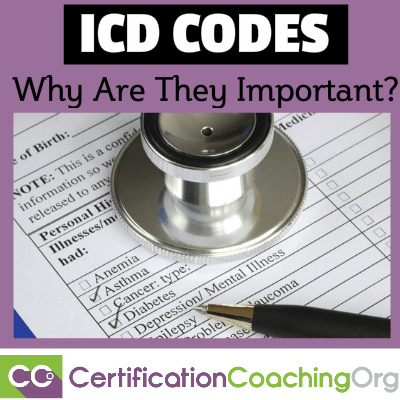What are ICD Codes?
ICD codes are alphanumeric designations given to every diagnosis, description of symptoms and cause of death attributed to human beings. These classifications are developed, monitored and copyrighted by the World Health Organization (WHO). In the United States, the NCHS (National Center for Health Statistics), part of CMS (Centers for Medicare and Medicaid Services) oversees all changes and modifications to the ICD codes, in cooperation with WHO.
While ICD codes are still used to track the incidence and spread of diseases and injury, their most important facet today is demonstrating medical necessity in claims. In other words, ICD codes explain to the insurance payer why the doctor performed a certain procedure. Source: http://patients.about.com/od/medicalcodes/a/icdcodes.htm
ICD Code Sets and Their Uses
There are several lists of these codes, all of which relate to each other. While the code numbers may be the same, sometimes they will have extra numbers or letters attached to them for different uses. In these examples, the use of # will relate to a number.
- ICD-##-CM codes are used for diagnosis purposes. CM means “clinical modification.” It is used by hospitals and other facilities to describe any health challenges a patient has, from his diagnosis to symptoms to outcomes from treatment, to causes of death. As we move more and more into electronic medical records, these codes will be used even further by physicians and other medical professionals.
- ICD codes are used by government health authorities to track certain diseases
- ICD codes are also used to describe a cause of death.
- ICD codes are used internationally
Source: http://patients.about.com/od/medicalcodes/a/icdcodes.htm
Understanding ICD 10 CM – Medical Coding Books

What does ICD-9, ICD-10 and Others Mean?
ICD-9 — The code that’s currently in use in the United States is the Ninth Revision, Clinical Modification, or ICD-9-CM. ICD-9, the code set on which ICD-9-CM is based, was published in 1978. It was adapted for use in the United States in the same year. Note that ICD-9-CM is used only in the United States. Source: http://www.medicalbillingandcoding.org/icd-9-icd-9-cm/
ICD-9-CM codes are three-to-five digit numeric and, in certain cases, alphanumeric codes. The first three digits in a code are called the “category.” The category describes the general illness, injury, or condition of the patient. In many cases, the category is not specific enough to describe the full extent of the patient’s condition. Take dementia, for example. The basic ICD-9-CM code for dementia is 290. These first three numbers are the category, but since dementia is such a complicated condition, you would almost never stop coding at this level.
Here’s the framework:
“123 – {Disease} (The first three digits make up the category)
- 123.0 – {Disease} in Chest (The zero after the decimal point is the subcategory. It relates an important designation about the disease.)
- 123.00 -… uncomplicated
- 123.01 – … with complications in cardiac system
- 123.02 – … with complications in digestive system (the last digit is the subclassification. This gives even further information about the designation outlined in the subcategory. If we were to select 123.02 as our code, we’d read the full code as “{Disease} in chest, with complications in the digestive system.”
- 123.0 – Disease in legs
- And so on…”
Learn more about ICD-9 and ICD-9-CM Codes from this source: http://www.medicalbillingandcoding.org/icd-9-icd-9-cm/
ICD-10 — The International Classification of Diseases, Tenth Edition (ICD-10) is a clinical cataloging system that goes into effect for the U.S. healthcare industry on Oct. 1, 2015, after a series of lengthy delays. Accounting for modern advances in clinical treatment and medical devices, ICD-10 codes offer many more classification options compared to those found in predecessor ICD-9.
ICD-10 codes are approached differently and are quite different from their ICD-9 counterparts. These codes are broken down into chapters and subchapters. They are comprised of a letter plus two digits to the left of the decimal point, then one digit to the right. The letters group diseases. All codes preceded by a C indicate a malignancy (cancer), codes preceded by a K indicate gastrointestinal problems, and so forth.
Examples are:
- A02.0 indicates a salmonella infection
- I21.X refers to myocardial infarction
- M16.1 is used for arthritis in the hip
- Q codes represent genetic abnormalities, like Q35 for a baby born with a cleft palate
- U codes are for new problems that develop over time. Any of the antibiotic resistant “superbugs” that develop over time will fall into the U category.
ICD-11, the next major update, is in development but does not have a designated implementation date.
Source: http://patients.about.com/od/medicalcodes/a/findicdcode.htm

![[CCO] Certification Coaching Organization LLC [CCO] Certification Coaching Organization LLC](https://www.cco.us/wp-content/uploads/2015/05/CCO-Logo-2015-d3-500px.png)